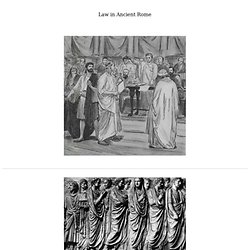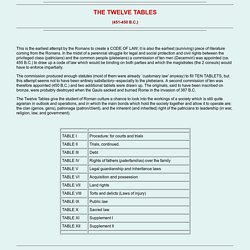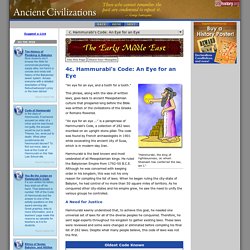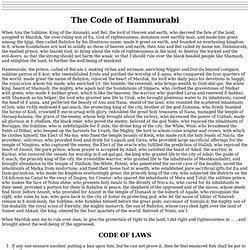

Full text of "The Twelve Tables" Timetable of World Legal History. As fragments of primitive animals have been kept for us sealed up in the earth's rocks, so fragments of primitive institutions have been preserved, embedded in the rocks of surviving law or custom, mixed up with the rubbish of accumulated tradition, crystallized in the organization of still savage tribes, or kept curiously in the museum of fact and rumor swept together by some ancient historian.1 Some form of law, is always the foundation of even primitive institutions.

Law, as it were, has travelled a long, long blood-stained path. From acts so barbaric that they defy belief, to a modern world where much if not most of the world population is exempt from the tyrannical Rule of Man system, and benefit from a transparent Rule of Law. This time-table looks at the significant steps in the ongoing evolution of law on our planet. ► See also the Law's Hall of Fame ► On the Origin of Law 2350 BC: Urukagina's Code 2050 BC: Ur-Nammu's Code 1850 BC: The Earliest Known Legal Decision 621 BC: Draco's Law.
Law in Ancient Rome, The Twelve Tables. Law in Ancient Rome Roman law is the legal system of ancient Rome, and the legal developments which occurred before the 7th century AD - when the RomanÐByzantine state adopted Greek as the language of government.

The development of Roman law comprises more than a thousand years of jurisprudence - from the Twelve Tables (c. 439 BC) to the Corpus Juris Civilis (AD 529) ordered by Emperor Justinian I. This Roman law, the Justinian Code, was effective in the Eastern Roman (Byzantine) Empire (331-1453), and also served as a basis for legal practice in continental Europe, as well as in Ethiopia, and most former colonies of European nations, including Latin America. THE TWELVE TABLES. This is the earliest attempt by the Romans to create a CODE OF LAW; it is also the earliest (surviving) piece of literature coming from the Romans.

In the midst of a perennial struggle for legal and social protection and civil rights between the privileged class (patricians) and the common people (plebeians) a commission of ten men (Decemviri) was appointed (ca. 455 B.C.) to draw up a code of law which would be binding on both parties and which the magistrates (the 2 consuls) would have to enforce impartially. The commission produced enough statutes (most of them were already `customary law' anyway) to fill TEN TABLETS, but this attempt seems not to have been entirely satisfactory--especially to the plebeians. A second commission of ten was therefore appointed (450 B.C.) and two additional tablets were drawn up. Hammurabi's Code: An Eye for an Eye. "Hammurabi, the king of righteousness, on whom Shamash has conferred the law, am I.

" "An eye for an eye, and a tooth for a tooth. " This phrase, along with the idea of written laws, goes back to ancient Mesopotamian culture that prospered long before the Bible was written or the civilizations of the Greeks or Romans flowered. "An eye for an eye ... " is a paraphrase of Hammurabi's Code, a collection of 282 laws inscribed on an upright stone pillar. The code was found by French archaeologists in 1901 while excavating the ancient city of Susa, which is in modern-day Iran. The Code of Hammurabi ~1700 BCE. When Anu the Sublime, King of the Anunaki, and Bel, the lord of Heaven and earth, who decreed the fate of the land, assigned to Marduk, the over-ruling son of Ea, God of righteousness, dominion over earthly man, and made him great among the Igigi, they called Babylon by his illustrious name, made it great on earth, and founded an everlasting kingdom in it, whose foundations are laid so solidly as those of heaven and earth; then Anu and Bel called by name me, Hammurabi, the exalted prince, who feared God, to bring about the rule of righteousness in the land, to destroy the wicked and the evil-doers; so that the strong should not harm the weak; so that I should rule over the black-headed people like Shamash, and enlighten the land, to further the well-being of mankind.
